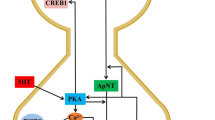Abstract
Effects of the antiepileptic drug carbamazepine on nerve action potential and transmitter release in mouse neuroblastoma-glioma hybrid cells (NG108-15) and the frog neuromuscular junction were studied. Carbamazepine within a concentration range of 0.1–0.5 mmol/L reduced the peak height of the action potential of the NG108-15 cells, whereas the membrane potential and membrane resistance were unaffected. Voltage clamp revealed that the decrease in the action potential was due to the blockage of the Na+, delayed K+ and transient Ca2+ currents. Carbamazepine did not affect Ca2+-activated and A type K+ currents and long-lasting Ca2+ current. In the frog neuromuscular junction, carbamazepine decreased the mean quantal content by a parallel shift in the frequency augmentation–potentiation (FAP) relation. It is concluded that carbamazepine blocks the voltage-dependent Na+, delayed K+, and transient Ca2+ currents and quantal transmitter release through a decrease of nerve excitation.
Similar content being viewed by others
References
Alderdice MT, Trommer BA. Differential effects of the anti-convulsants phenobarbital, ethosuximide and carbamazepine on neuromuscular transmission. J Pharmacol Exp Ther. 1980;215:92–6.
Aronson JK. Potassium channels in nervous tissue. Biochem Pharmacol. 1992;43:11–4.
Backus KH, Pflimlin P, Trube G. Action of diazepam on the voltage-dependent Na+ current: comparison with the effects of phenytoin, carbamazepine, lidocaine and flumazenil. Brain Res. 1991;548:41–9.
Enomoto K, Higashida H, Maeno T. Effects of toki-shakuyakusan (Tsumura TJ-23) on electrical activity in neuroblastoma cells and frog neuromuscular junctions. Neurosci Res. 1992; 15:81–9.
Furuya K, Furuya S, Yamagishi S. Developmental time courses of Na and Ca spikes in neuroblastoma × glioma hybrid cells. Dev Brain Res. 1983;11:229–34.
Hamill OP, Marty A, Neher E, Sakmann B, Sigworth FJ. Improved patch-clamp techniques for high-resolution current recording from cells and cell-free membrane patches. Pflugers Arch. 1981;391:85–100.
Hille B. Potassium channels and chloride channels. In: Ionic channels of excitable membranes. Sunderland MS: Sinauer Associates; 1984:113.
Kasai H, Neher E. Dihydropyridine-sensitive and ω-conotoxin-sensitive calcium channels in a mammalian neuroblastomaglioma cell line. J Physiol. 1992;448:161–88.
Kito M, Maehara M, Watanabe K. Antiepileptic drugs-calcium current interaction in cultured human neuroblastoma cells. Seizure. 1994;3:141–9.
Lancaster JM, Davies JA. Carbamazepine inhibits NMDA-induced depolarizations in cortical wedges prepared from DBA/2 mice. Experientia. 1992;48:751–3.
Lang DG, Wang CM, Cooper BR. Lamotrigine, phenytoin and carbamazepine interactions on the sodium current present in N4TG1 mouse neuroblastoma cells. J Pharmacol Exp Ther. 1993;266:829–35.
Macdonald RL, Kelly KM. Antiepileptic drug mechanisms of action. Epilepsia. 1995;36:S2–12.
Maeno T, Enomoto K. Kinetic analysis of transmitter release in neuromuscular transmission. Adv Biophys. 1988;24:93–122.
Morselli PL. Carbamazepin: absorption, distribution and excretion. In: Levy R, Mattson R, Meldrum B, Penry JK, Dreifuss FE, eds. Antiepileptic drugs. New York: Raven Press; 1989:473–90.
Nowycky MC, Fox AP, Tsien RW. Three types of neuronal calcium channel with different calcium agonist sensitivity. Nature. 1985;404:440–3.
Olpe H, Kolb CN, Hausdorf A, Haas HL. 4-Aminopyridine and barium chloride attenuate the anti-epileptic effect of carbamazepine in hippocampal slices. Experientia. 1991;47:254–7.
Robbins J, Sim JA. A transient outward current in NG108-15 neuroblastoma-glioma hybrid cells. Pflugers Arch. 1990; 416:130–7.
Schirrmacher K, Mayer A, Walden J, Dusing R, Bingmann D. Effects of carbamazepine on action potentials and calcium currents in rat spinal ganglion cells in vitro. Neuropsychobiology. 1993;27:176–9.
Twombly DA, Hermank MD, Kye CH, Narahashi T. Ethanol effects on two types of voltage-activated calcium channels. J Pharmacol Exp Ther. 1990;254:1029–37.
Walden J, Grunze H, Mayer A et al. Calcium-antagonistic effects of carbamazepine in epilepsies and affective psychoses. Neuropsychobiology. 1993;27:171–5.
Willow M, Gonoi T, Catterall WA. Voltage clamp analysis of the inhibitory actions of diphenylhydantoin and carbamazepine on voltage-sensitive sodium channels in neuroblastoma cells. Mol Pharmacol. 1985;27:549–58.
Author information
Authors and Affiliations
Rights and permissions
About this article
Cite this article
Matsumoto, Y., Enomoto, K., Moritake, K. et al. Effects of carbamazepine on nerve activity and transmitter release in neuroblastoma-glioma hybrid cells and the frog neuromuscular junction. Cell Biol Toxicol 14, 191–198 (1998). https://doi.org/10.1023/A:1007410509772
Issue Date:
DOI: https://doi.org/10.1023/A:1007410509772




